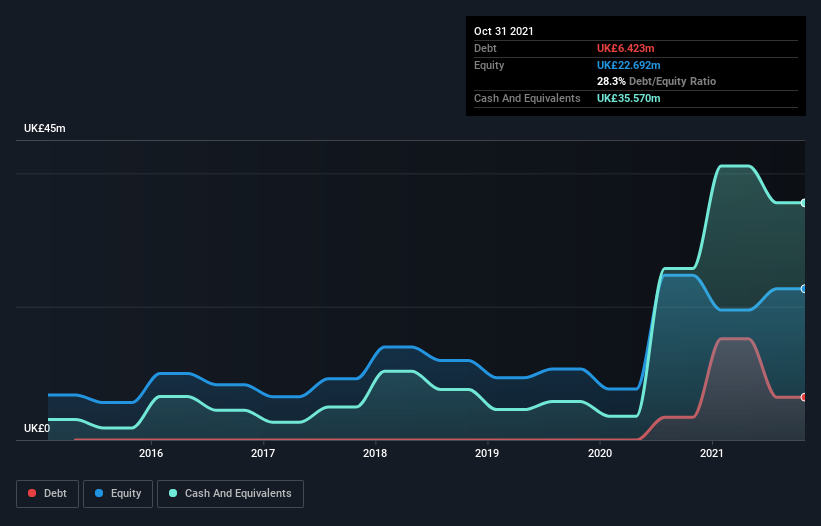Scancell Holdings (LON:SCLP) Has Debt But No Earnings; Should You Worry?
David Iben put it well when he said, 'Volatility is not a risk we care about. What we care about is avoiding the permanent loss of capital.' It's only natural to consider a company's balance sheet when you examine how risky it is, since debt is often involved when a business collapses. We note that Scancell Holdings plc (LON:SCLP) does have debt on its balance sheet. But should shareholders be worried about its use of debt?
Why Does Debt Bring Risk?
Debt is a tool to help businesses grow, but if a business is incapable of paying off its lenders, then it exists at their mercy. Ultimately, if the company can't fulfill its legal obligations to repay debt, shareholders could walk away with nothing. However, a more frequent (but still costly) occurrence is where a company must issue shares at bargain-basement prices, permanently diluting shareholders, just to shore up its balance sheet. Of course, debt can be an important tool in businesses, particularly capital heavy businesses. When we think about a company's use of debt, we first look at cash and debt together.
View our latest analysis for Scancell Holdings
How Much Debt Does Scancell Holdings Carry?
The image below, which you can click on for greater detail, shows that at October 2021 Scancell Holdings had debt of UK£6.42m, up from UK£3.41m in one year. However, its balance sheet shows it holds UK£35.6m in cash, so it actually has UK£29.1m net cash.
How Strong Is Scancell Holdings' Balance Sheet?
The latest balance sheet data shows that Scancell Holdings had liabilities of UK£1.60m due within a year, and liabilities of UK£20.4m falling due after that. Offsetting these obligations, it had cash of UK£35.6m as well as receivables valued at UK£2.86m due within 12 months. So it can boast UK£16.4m more liquid assets than total liabilities.
This short term liquidity is a sign that Scancell Holdings could probably pay off its debt with ease, as its balance sheet is far from stretched. Succinctly put, Scancell Holdings boasts net cash, so it's fair to say it does not have a heavy debt load! The balance sheet is clearly the area to focus on when you are analysing debt. But ultimately the future profitability of the business will decide if Scancell Holdings can strengthen its balance sheet over time. So if you want to see what the professionals think, you might find this free report on analyst profit forecasts to be interesting.
Since Scancell Holdings doesn't have significant operating revenue, shareholders may be hoping it comes up with a great new product, before it runs out of money.
So How Risky Is Scancell Holdings?
Statistically speaking companies that lose money are riskier than those that make money. And in the last year Scancell Holdings had an earnings before interest and tax (EBIT) loss, truth be told. Indeed, in that time it burnt through UK£11m of cash and made a loss of UK£8.4m. But at least it has UK£29.1m on the balance sheet to spend on growth, near-term. Even though its balance sheet seems sufficiently liquid, debt always makes us a little nervous if a company doesn't produce free cash flow regularly. When analysing debt levels, the balance sheet is the obvious place to start. However, not all investment risk resides within the balance sheet - far from it. For example, we've discovered 2 warning signs for Scancell Holdings that you should be aware of before investing here.
When all is said and done, sometimes its easier to focus on companies that don't even need debt. Readers can access a list of growth stocks with zero net debt 100% free, right now.
Have feedback on this article? Concerned about the content? Get in touch with us directly. Alternatively, email editorial-team (at) simplywallst.com.
This article by Simply Wall St is general in nature. We provide commentary based on historical data and analyst forecasts only using an unbiased methodology and our articles are not intended to be financial advice. It does not constitute a recommendation to buy or sell any stock, and does not take account of your objectives, or your financial situation. We aim to bring you long-term focused analysis driven by fundamental data. Note that our analysis may not factor in the latest price-sensitive company announcements or qualitative material. Simply Wall St has no position in any stocks mentioned.

 Yahoo Finance
Yahoo Finance 
